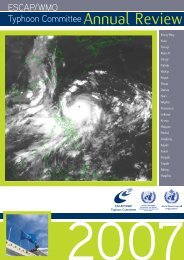TCAR - Typhoon Committee
TCAR - Typhoon Committee
TCAR - Typhoon Committee
You also want an ePaper? Increase the reach of your titles
YUMPU automatically turns print PDFs into web optimized ePapers that Google loves.
the degree of similarity. According to this index,<br />
several historical tropical cyclones were identified<br />
as the samples similar to the predicted ones. 6-48<br />
precipitation predictions were made at each station<br />
using the weighted similarity index from historical<br />
precipitation records. Tests demonstrated that this<br />
technique showed a certain prediction skill in terms of<br />
quantitative precipitation at specific sites, compared<br />
with the climatology and persistency method.<br />
Vortex Cycle Assimilation in GRAPES-TCM<br />
Based on MC-3DVAR approach (Liang et al., 2007a,<br />
b), vortex cycle assimilation was implemented on the<br />
IBM supercomputer for the initialization of GRAPES-<br />
TCM. The real time verification on the new scheme,<br />
in comparison with the original operational vortex<br />
relocation scheme, showed that the new scheme<br />
improved the 24-48h TC track forecasts in 2009 to<br />
some extent.<br />
Advances of Physics Parameterization Schemes for<br />
GRAPES-TCM<br />
An improved Kain-Fritsch scheme (Ma and Tan,<br />
2009) was implanted in GRAPES-TCM. In addition, in<br />
an effort to improve the TC intensity prediction, the<br />
original roughness drag parameterization scheme in<br />
GRAPES-TCM was improved according to a number<br />
of recent observational and numerical studies (Powell<br />
et al. 2003; Moon et al. 2007).<br />
Tropical Cyclone Initialization based on UWPBL<br />
Model<br />
A new approach was proposed to improve the<br />
initialization of regional TC prediction model. This<br />
approach first modified the roughness according to<br />
the TC-induced high wind in the planetary boundary<br />
layer model. Then the QuikSCAT sea surface winds<br />
were used to satisfy the related gradient winds, and<br />
wind pressure fields controlled by the secondary<br />
circulations and thermal stratification in the boundary<br />
layer. Finally, the 3DVAR was used to assimilate the<br />
wind fields in the meso-scale model, to improve<br />
initialization of TC circulation and prediction. . The<br />
numerical sensitivity experiments on two typical<br />
typhoons suggested that this approach improved<br />
TC initial wind fields and intensity at sea level while<br />
maintaining the non-geostrophic equilibrium between<br />
TC wind fields and the steering flow.<br />
Development on Regional Ocean-Atmosphere<br />
Coupled Model<br />
A Regional Ocean-Land-Atmosphere Coupled<br />
Model was preliminary developed in combination<br />
with an advanced ocean model, GRAPES-TCM,<br />
<strong>TCAR</strong><br />
CHAPTER 1 - TYPHOON COMMITTEE ACTIVITIES<br />
and a numerical coupler for dynamical and energy<br />
transition. Numerical experiments on this coupled<br />
model showed promising results.<br />
TC Ensemble prediction<br />
The sensitivity of TC rainfall and intensity prediction<br />
to physics parameterization was preliminary<br />
investigated. Results provided a basis for upgrading<br />
the Shanghai <strong>Typhoon</strong> Ensemble Prediction System.<br />
Research was carried out to apply dropwindsondes<br />
and intensive sounding data in typhoon forecasting<br />
models.<br />
Fig. 16:The Track of <strong>Typhoon</strong> Morakot (0908)<br />
(Red curve: assimilation tests; blue curve: control test;<br />
black curve: observations)<br />
For the control test (i.e., in the operational model),<br />
the typhoon track prediction was satisfactory for<br />
72 h. For the 06-24 h forecasts, the largest error<br />
was 91 km. The maximum error appeared in 30 h<br />
(137 km). For the forecast from then on to 72-h, the<br />
error was less than 80 km, suggesting that GZTCM<br />
was relatively accurate in forecasting the tracks of<br />
<strong>Typhoon</strong> Morakot. Compared with the control test,<br />
the assimilation test was more than 30 km larger in<br />
the 66-h forecast error but smaller in the other time<br />
periods than those in the control test. Clearly, with the<br />
assimilation of dropwindsondes, the typhoon path was<br />
forecasted much better within 72 hours. For typhoon<br />
intensity prediction, the two tests were weaker than<br />
observation for the time within 54 hours but stronger<br />
than it beyond 54 hours, as shown in Figure 12. Within<br />
72 hours, except for being a bit poorer in 24-36 hours<br />
in the assimilation test than in the control, the forecast<br />
was closer to reality at other times.<br />
Progress on short-term climate prediction in<br />
relation to typhoon activity<br />
New schemes for seasonal prediction of frequencies<br />
2009<br />
35

















